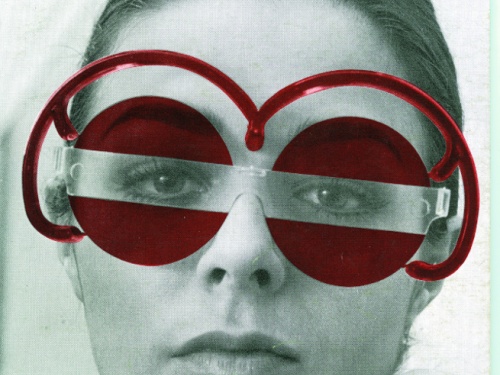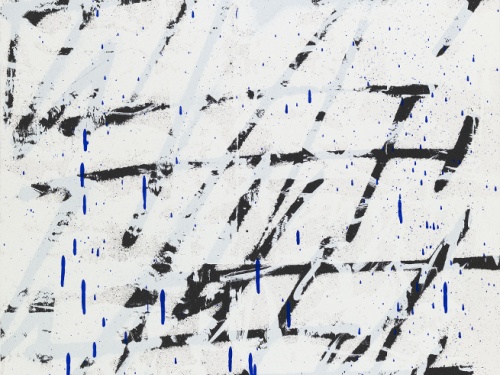Everything Relates: An Interview with Guan Xiao
To mark the opening of Guan Xiao: Flattened Metal in association with K11 Art Foundation, ICA Head of Programme Katharine Stout introduces the show, followed by an interview with Guan Xiao and curator Zian Chen.
Guan Xiao explores how present ways of seeing are influenced by digital image and information circulation, which have become an increasingly dominant source of knowledge exchange. In various sculptures, videos and installations Guan expands the aesthetic and cognitive possibilities for how meanings and identities are assigned and understood. Without seeking to compartmentalise or fix definitions, her work is occupied with our incomprehension of the past, and the way in which the unknown gives rise to intriguing discussion in the present. She juxtaposes references from the past and present (or future), weaving together both appropriated and originated visual and audio material, digital rendering techniques and found objects to create distinct and evocative installations that integrate so-called primitive and high-tech elements.
"Guan expands the aesthetic and cognitive possibilities for how meanings and identities are assigned and understood."
At the ICA, Guan Xiao’s first solo exhibition in the UK includes a new installation comprising five large printed screens, in front of which are placed sculptures made up of various materials, including muted speakers. As with previous works such as Documentary: Geocentric Puncture, 2012 and Documentary: From National Geographic to BBC, 2015, Guan optically merges the colour spectrum for the printed background screens (of the kind usually found in photographic studios) with the tonal range of the customised objects placed in front. The printed repetitive patterns are often taken from natural camouflaging phenomena such as animal or snake skins that are also reproduced artificially for clothing or accessories. Just as Guan is interested in finding formal equivalences rather than difference between the second and third dimensions in her object works, she sets out to explore the interdependent connections and flow between different ways of understanding the world and our place within it. For the first time, Guan Xiao will include text excerpts from other writers on the printed screens, such as quotes from the British anthropologist and systems theorist Gregory Bateson (1904 – 80) whose theoretical work embraced psychology, behavioural biology, evolution, systems theory, and cybernetics, as he worked toward a theoretical synthesis he referred to as “an ecology of mind.” For example, in his book Mind and Nature he asked, "What pattern connects the crab to the lobster and the orchid to the primrose and all the four of them to me? And me to you?"
The show also includes a recent video triptych, Action, 2014, that suggests open and fluid connections between sound, image and text as video clips sourced from a range of online sources including home movies, advertising and promotional videos are rhythmically juxtaposed across the three screens. Guan Xiao comments on the work, "For me, rhythm means all the intersections of sense. It’s a way I understand the associations between things. It helps me to try and transfer action, see listen, think about interactions and freely build a link between them."
Here Guan Xiao and Zian Chen, writer of fictional exhibitions, are in conversation about Guan’s approach to making the work, and her thinking behind it.
How does the ICA presentation relate to your core research interests?
Generally speaking, I understand my practice as exploring the logic by which things relate to each other or, in other words, the way in which human beings live in the world. While this unfolds in a myriad of ways, in different projects I’ve previously focused on the notion of equivalence and core sampling, for instance. For the presentation in ICA, what really concerns me is the condition of ‘conversation’.
"The five installations on view function like online keywords or tags, which recall multiple contexts."
The verb, to converse, means to “keep company,” but also “to turn” (vertere). It is an oral action that translates the character of things into language. Acting through a series of signifying chains, such a process implies necessary mistranslation for the sake of understanding: things have been taken out of their habitual community, and put into the community of signs. In the exhibition, the five installations on view function like online keywords or tags, which recall multiple contexts; they are not necessarily situated in one syntax only.
So rather than talking about politics of difference, your approach to the issue of identity resides in how to ‘blur’ it, and the association between things that you mentioned can be understood as various strategies of forming communities?
There is nuance when talking about blurring one’s identity. For example when I edit the video clips for my triptych work, I follow the principle of plurality by blurring them. When viewers look at the three screens, they perceive the work as a whole. In my sculptural works, I similarly avoid using material that singles itself out from the whole picture. The objects in the foreground are not the foremost protagonist, nor are those in the background. It is about collective voice and multi-focusing.
What is the significance of your use of mesh fabric as screens in the installation?
It was developed from previous installations in which I used camouflaged screens (The Documentary: Geometric Puncture, 2012, The Documentary: From National Geography to BBC, 2015, 4S Prequel, 2015). The use of camouflage, helped me to remove the choreographed objects from their habitual context. The camouflage creates a context in its own right. Furthermore, these kaleidoscopic patterns actively merge the visible boundary between the background and the subjects in front of them. For the new works on view at the ICA, Amazon Gold, Public Chair, Marble Floor, Little Drum and From Unit 3 to Unit 7, I utilise the mesh fabric for the screens (I formerly used vinyl fabric).
"I am always enchanted by things which encompass two opposite concepts."
It creates a semi-transparent condition for spectatorship that enables multi-focus viewing in physical encounters in the Lower Gallery. The source images are from the news and social documentations. In the visual assemblage, they merge into a pattern, which is a performative rendering based on my previous use of animal patterns.
Does this obsession with biological patterns come from fashion?
No, not entirely. I am always enchanted by things which encompass two opposite concepts. Take the snakeskin pattern as an example. First of all, it is creation of nature. Its formation rigidly follows its function instead of aesthetics. It is driven by the animal’s survival strategy: they respond to the environment. Meanwhile it looks incredibly artificial; the pattern is an aesthetic product per se. Such contradiction, I believe, endows things like these biological patterns with qualities that do not belong to any space and time, or to any classification. They are oddly indescribable. I am indeed also drawn to fashion, the associations between textures of skin, patterns and clothes. The influence of this highly developed industry is far more than the production of glamourous apparel. It encourages even more discussions and I hope to go further in this direction in the future.
Could you tell us a bit more about your use of muted speakers in the works Amazon Gold, Public Chair and From Unit 3 to Unit 7?
The speakers are integral to the entire body of installations. For me, even if they are muted, their physical or even visual presence evokes the presence of sound on site. While seeing the speakers, you think of sound. Just as I previously used camera lenses or CCTV in the works without their intended function, for me they still function metaphorically or even in a real sense. The concept is itself a material for the installation, just as with my use of the quotation from Gregory Bateson. In the same way that image sources come into my practice, it’s taken out of its original context.
I am curious about the idea behind Action which ends with the SONY slogan. I initially thought it implied a sense of sarcasm but on second thoughts it doesn’t seem so.
It was not intended as sarcasm. It is funny that most of people feel repelled instinctively when it comes to advertisement. I am not sure if such repulsion comes out of the coerciveness of advertisement or its repetitive attempts to shape our value system. There is nothing wrong about such visuality per se - at least I am not offended by it. And as my work studies the delivery of ideas, I am often inspired by good advertisements. I have always been fond of SONY’s “make believe” slogan. I think for the general public, artists do spend most of their time making believe. Its premise is, however, that artists don’t have to ‘make’ it - they live in it. Sometimes a thought is too true for them and they express it! ■
Guan Xiao: Flattened Metal in association with K11 Art Foundation runs 20 April - 19 June.
This article is posted in: Articles, Blog, Exhibitions, Interviews, Members News
Tagged with: Guan Xiao, K11 Art Foundation, Guan Xiao: Flattened Metal, Katharine Stout, Zian Chen, Exhibitions, interview, interviews, Gregory Bateson, China










